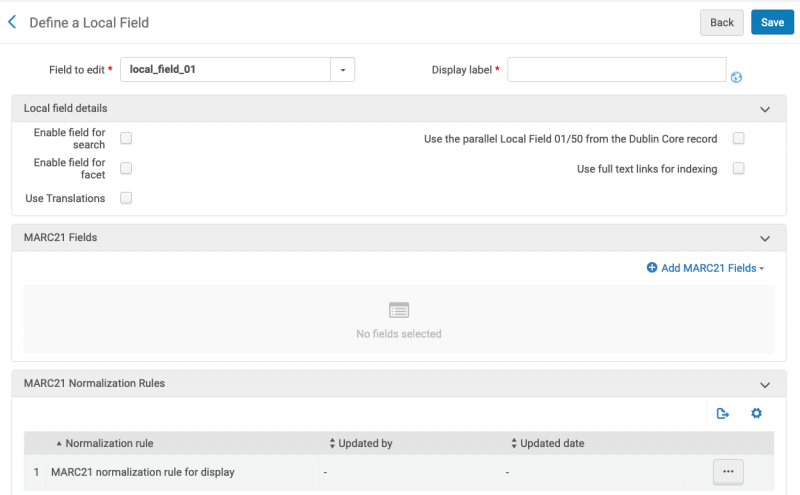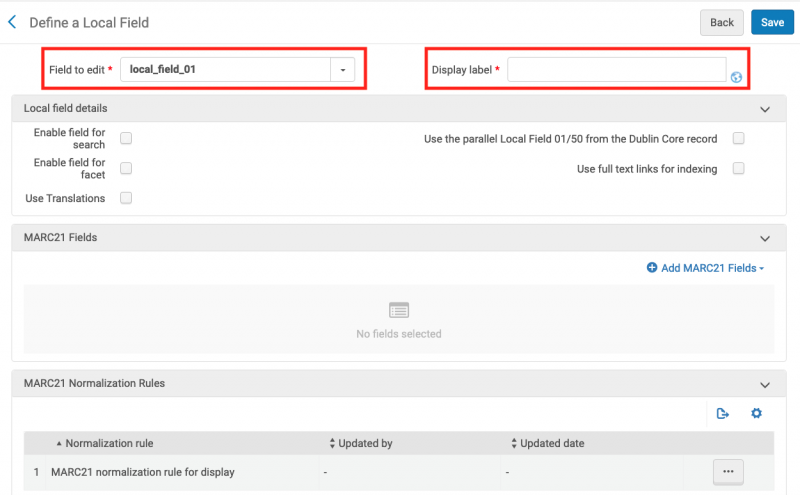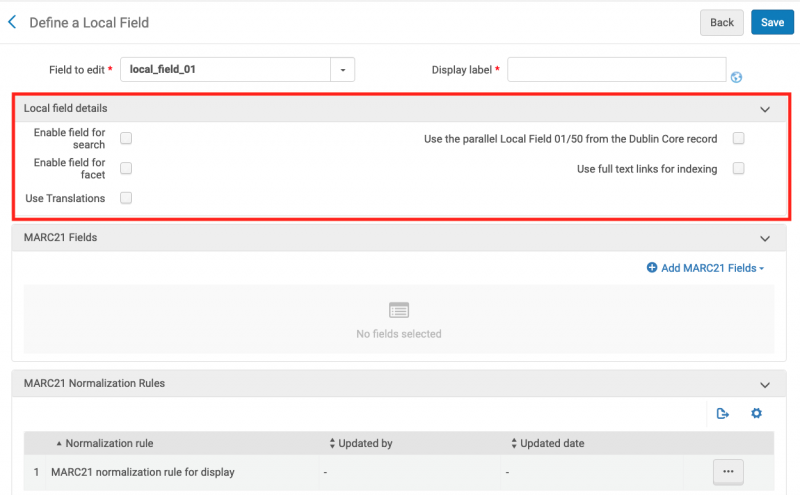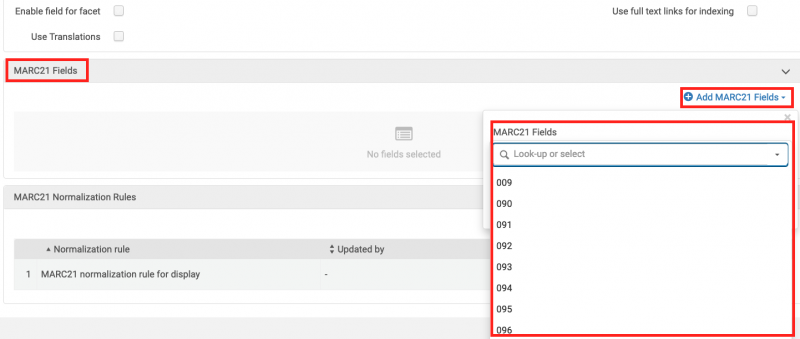Local Fields in Primo VE for I-Share
Revised: July 21, 2025
Overview
Local Fields for Primo VE are additional MARC bibliographic fields that can be configured to display and be used for search and faceting beyond the default fields pre-configured in the Primo VE system. I-Share institutions are able to set up Local Fields for Primo VE in their Alma IZs, but in our shared consortial environment, Local Fields have effects beyond just your local Primo VE instance.
Local Fields in Primo VE can be created by two methods: the MARC21 Fields Method or the Normalization Rule Method. For more details on these two methods, please see below.
Local Fields for I-Share
The CARLI Discovery Primo VE Committee has identified a set of common fields for display (and in some cases, search and/or facets) that have been distributed from the NZ to all I-Share IZs in Local Fields 51-100.
All fields below can be set up for display. Those that can be set up for Search and/or Facet are noted in the fourth column.
| Local Field number | Local Field name | MARC field definitions | Use for Search and/or Facet? | Status |
| local_field_51 | Attribution | 245 $c | no | Distributed 1/16/2025 |
| local_field_52 | Publishers | 260 $b and 264 $b | Search - yes | Distributed 1/16/2025 |
| local_field_53 | Playing Time (hh:mm:ss) | 306$a | no | Distributed 1/16/2025 |
| local_field_54 | Technical Specifications | 344 $abcdefghij and 345 $ab3 | no | Distributed 1/16/2025 |
| local_field_55 | Arrangement | 351 $abc3 | no | Distributed 5/8/2025 |
| local_field_56 | Audience | 385 $a, 521, and 008[22] | Search - yes; Facet - yes | Distributed 1/16/2025 |
| local_field_57 | Creator Characteristics | 386 $ai3 | Search - yes; Facet - yes | Distributed 1/16/2025 |
| local_field_58 | General Notes | 500, 515, 550 | Search - yes | Distributed 7/26/2024 |
| local_field_59 | Item Specific Notes | 501, 533, 544, 562 | Search - yes | Distributed 7/26/2024 |
| local_field_60 | Bibliography | 504 | no | Distributed 7/26/2024 |
| local_field_61 | Restrictions | 506 | no | Distributed 7/26/2024 |
| local_field_62 | Production Credits | 508 | Search - yes | Distributed 7/26/2024 |
| local_field_63 | References | 510 | Search - yes | Distributed 7/26/2024 |
| local_field_64 | Performer | 511 | Search - yes | Distributed 7/26/2024 |
| local_field_65 | Event | 518 | Search - yes | Distributed 7/26/2024 |
| local_field_66 | Cite As | 524 | no | Distributed 7/26/2024 |
| local_field_67 | Supplement | 525 | no | Distributed 7/26/2024 |
| local_field_68 | Physical Description | 530 | no | Distributed 7/26/2024 |
| local_field_69 | System Details | 538 | no | Distributed 7/26/2024 |
| local_field_70 | Use Restrictions | 540 | no | Distributed 7/26/2024 |
| local_field_71 | Source of Acquisition | 541 | no | Distributed 7/26/2024 |
| local_field_72 | Biographical/Historical Note | 545 | no | Distributed 7/26/2024 |
| local_field_73 | Language Notes | 546 | no | Distributed 7/26/2024 |
| local_field_74 | Index/Finding Aids | 555 | no | Distributed 7/26/2024 |
| local_field_75* | Ownership History | 561 | no | Distributed 7/26/2024 |
| local_field_76* | Binding Information | 563 | no | Distributed 7/26/2024 |
| local_field_77 | Related Items | 580 | Search - yes | Distributed 7/26/2024 |
| local_field_78 | Publications | 581 | no | Distributed 7/26/2024 |
| local_field_79 | Action Note | 583 | no | Distributed 7/26/2024 |
| local_field_80 | Exhibition | 585 | Search - yes | Distributed 7/26/2024 |
| local_field_81 | Awards | 586 | Search - yes | Distributed 7/26/2024 |
| local_field_82 | Local Notes | 590 - 599 | Search - yes | Distributed 7/26/2024 |
| local_field_83 | Dates of Publication | 362 $az | no | Distributed 5/8/2025 |
| local_field_84 | Musical Key | 384 $a3 | Search - yes; Facet - yes | Distributed 5/8/2025 |
| local_field_86 | Numeric Designation of Musical Work | 383 $abe3 | Search - yes; Facet - yes | Distributed 5/8/2025 |
| local_field_87 | Instrumentation | 382 $aben3 | Search - yes | Distributed 5/8/2025 |
*Please note that not all Local Fields can be Local Extensions in the Alma Metadata Editor. In a shared bibliographic environment like I-Share, some Local Fields may not be appropriate for data that is unique to your library's copy. For example, while Ownership History (local_field_75*, MARC 561) and Binding History (local_field_76*, MARC 563) are defined consortially as Local Fields, when a bibliographic record is shared in the network, these data are not appropriate for all I-Share libraries and may not persist if the bib record is replaced/updated in future. Such library-specific data may be better suited to the holdings record notes fields rather than bib record notes. See also CARLI documentation on I-Share Common Definitions for Local Extensions and How-To: Using Local Extensions for Copy-Specific Bibliographic Data.
I-Share libraries may choose how to configure the distributed consortial field(s) for display in their Primo VE (or not):
- How to Add a Field to a Display Line in the Brief Record – This procedure allows you to add the local field to a display line in the record's brief record section.
- How to Configure the Details Service to add the field to the Full Record – This procedure allows you to display the local field in the Details section on the full record display page.
- How to Add a Search Index – This procedure allows you to add the local search field on the Advanced Search page. "Enable field for search" must be checked first in the field definition.
- How to Add a Local Facet – This procedure allows you to add the local facet on the Brief Results page. "Enable field for facet" must be checked first in the field definition.
- I-Share libraries may change the Local Field name, if desired.
Current Concerns for Local Fields in the I-Share Environment
In a shared Primo VE network environment such as CARLI's, Ex Libris documentation strongly advises against individual Institution Zones (IZ) using the Local Fields Normalization Rule Method unless those Normalization Rules are coordinated and identical across the consortium in every IZ and the Network Zone (NZ). CARLI staff are investigating further to understand the full extent of this recommendation, but tests suggest that if the Normalization Rules are not coordinated and identical, users may see record data differently depending on how and where they search.
Even with the Local Fields MARC21 Field Method (see the "How to Create Local Fields" section below on more information about this method of creating Local Fields), Ex Libris documentation recommends that consistent usage of Local Fields across IZs is desirable so that a user does not experience changing display data when switching search scope or when switching between their local Primo VE view for their institution and the Primo VE Union View. To date, I-Share libraries have not coordinated Local Fields established under the MARC21 Field Method, but we may need to do so in future.
I-Share institutions can set up and configure additional Local Fields in Primo VE for display, searching, or facets by using the MARC21 Field Method. See step-by-step instructions below.
If an I-Share institution has a MARC bibliographic field that you would like to display that is not possible using the MARC21 Field Method—that is, outside of the set 009, 09X, 490, 5XX, 69X, 9XX, or a field within that set that requires conditional logic—contact CARLI Support so that we can maintain a list of such fields for future consortial consideration.
I-Share institutions should not configure any Local Fields for Primo VE using the Normalization Rule Method.
If your institution has already used the Normalization Rule Method to create Local Fields, please notify CARLI Support at so that we can work with you to test network implications and consider if these fields could be consortial fields.
If you have any suggestions for other Local Fields to be configured consortially, please submit them to CARLI Support or the he CARLI Discovery Primo VE Committee for consideration. Thank you!
How to Create Local Fields for I-Share Institutions
Local Fields in Primo VE can be created by two methods--the MARC21 Fields Method or the Normalization Rule Method--but as discussed above, I-Share institutions should use the MARC21 Fields Method only. The Ex Libris documentation Managing and Displaying Local Fields for Primo VE describes all possible options for how to create Local Fields, but a straightforward overview of the process using the MARC21 Fields Method is as follows.
You will need to role of Discovery Admin to create local fields using the MARC21 Fields Method:
- On the Manage Display and Local Fields page (Alma Configuration Menu > Discovery > Display Configuration > Manage display and local fields), click on the "Add field" link.

- Select "Add local field" from the Add field drop-down list.

- The Define a Local Field page will open.

- Choose the Field to edit from the dropdown list and input the Display label you wish to use.

- In the "Local field details" section, check the boxes to choose the options you want for this field.
- Enable field for search - Select if you want this field to be searchable by users in a separate index. All Local Fields are automatically indexed for keyword searches.
- Enable field for facet - Select if you want this field to be used as a facet to filter search results.
- Use Translations - Primo VE will display the translations defined in the Local Field Translate code table.
- Use the parallel Local Field 01/50 from the Dublin Core record - For Dublin Core records only if you have defined DC normalization rules to map this field to an associated discovery.local field.

- In the "MARC21 Fields" section, click Add MARC21 Fields to choose the MARC field(s) from the available list (009, 09X, 490, 5XX, 69X, and 9XX) that should make up this Local Field. You may choose one or multiple fields. Note: if the field you wish to use is not listed here, that means it cannot be configured using the MARC21 Fields Method; please contact CARLI Support. NOTE: DO NOT configure the "MARC21 Normalization Rules" section below it containing the "MARC21 normalization rule for display"; leave that default rule unedited and empty.

- Click Save to create the local field and to return to the Manage Display and Local Fields page.

- Back on the Manage Display and Local Rules page with the list of local fields that have been configured, click the "Apply rules" link in the upper right.
- Now that the Local Field has been established, you now need to configure it to display in the Brief or Full record views, and/or add it to the Advanced Search page, and/or add the Facet to display in the search results, depending on what you would like to use the field for:
- How toAdd a Field to a Display Line in the Brief Record – This procedure allows you to add the local field to a display line in the record's brief record section.
- How toConfigure the Details Service to add the field to the Full Record – This procedure allows you to display the local field in the Details section on the full record display page.
- How to Add a Search Index – This procedure allows you to add the local search field on the Advanced Search page. You must have checked "Enable field for search" in the field definition.
- How toAdd a Local Facet – This procedure allows you to add the local facet on the Brief Results page. You must have checked "Enable field for facet" in the field definition.
Additional Information about Local Fields
Primo VE comes pre-configured with a set of MARC bibliographic fields for display, search, and facets.
- Most but not all of the fields are set to display automatically.
- Most but not all of the fields are set to be searched automatically.
- Some of the fields are set to be used as facets automatically.
The Ex Libris document Mapping to the Display, Facets, and Search Sections in the Primo VE Record details the mapping of MARC bibliographic data for display, searching, and faceting in Primo VE.
An IZ can have up to 50 Local Fields (01-50). As a consortium, CARLI can distribute up to 50 more Local Fields from the NZ (51-100), for a total of 100 possible Local Fields.
On the Alma Configuration Form I-Share libraries filled out during migration to Alma, some institutions listed specific local fields that Ex Libris staff set up for them as part of migration.
Local Fields. vs. Local Extensions
Local Fields should not be confused with Local Extensions, which are a set of fields (09X, 59X, 69X, 77X, 78X, 9XX) that can be applied to bibliographic records in Alma to indicate local IZ data in a shared network bib record.
- Some Local Extensions can also be Local Fields for display, search, and facet: 09X, 59X, 69X, 9XX.
- See also CARLI documentation on I-Share Common Definitions for Local Extensions and How-To: Using Local Extensions for Copy-Specific Bibliographic Data.

